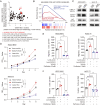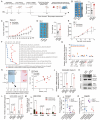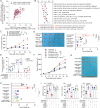The DCDC2/ENO1 axis promotes tumor progression and immune evasion in intrahepatic cholangiocarcinoma via activating FGL1-LAG3 checkpoint
- PMID: 40533767
- PMCID: PMC12175362
- DOI: 10.1186/s13046-025-03436-1
The DCDC2/ENO1 axis promotes tumor progression and immune evasion in intrahepatic cholangiocarcinoma via activating FGL1-LAG3 checkpoint
Abstract
Background & aims: ICC is a malignant tumor that originates from the intrahepatic bile ducts with insidious symptoms and a poor prognosis. Early diagnosis methods and therapeutic targets are urgently needed for ICC.
Methods: We utilized a comprehensive set of analytical techniques to elucidate the role and mechanisms of DCDC2 in ICC. Our study included protein microarrays, transcriptome analysis, functional assays, immunofluorescence, dual-luciferase reporter assays, as well as xenograft models and humanized PBMC models.
Results: Our study demonstrates that elevated levels of anti-DCDC2 autoantibodies in the serum of ICC patients indicate its potential utility as a diagnostic biomarker. Comprehensive in vitro and in vivo analyses reveal that DCDC2 promotes ICC proliferation, metastasis, and immune evasion. Mechanistically, DCDC2 stabilizes ENO1, resulting in enhanced AKT phosphorylation and increased expression of FGL1. Notably, elevated FGL1 levels significantly impair CD8+ T cell functionality via the FGL1-LAG3 axis.
Conclusion: Our findings position anti-DCDC2 autoantibody as a promising diagnostic biomarker for ICC, associated with poor prognostic outcomes, and elucidate its critical role in tumor growth and immune evasion through its interaction with ENO1.
Keywords: Doublecortin domain containing 2; Enolase 1; Fibrinogen-like protein 1; Immune evasion; Intrahepatic Cholangiocarcinoma; Progression; Tumor-associated antigen.
© 2025. The Author(s).
Conflict of interest statement
Declarations. Ethics approval and consent to participate: The animal research was approved by the Institutional Animal Care and Use Committee of Shanghai Immunocan Biotechnology Co., Ltd (Approval Number: YMNK-AUA-01201, Approval Date: February 17th, 2023). The human research was approved by the Clinical Research Ethics Committee of Fudan University Zhongshan Hospital (Approval Number: B2023-299R2, Approval Date: December 11, 2023). Additionally, it should be noted that at our teaching hospital, all patients admitted for surgical procedures are required to sign consent forms allowing for the use of their surgical specimens for research purposes. Therefore, research involving surgical specimens is exempt from the requirement for explicit informed consent. Consent for publication: All authors have agreed with publishing this manuscript. Competing interests: The authors declare no competing interests.
Figures









Similar articles
-
Circ_0084927 promotes progression of intrahepatic cholangiocarcinoma by sponging miR-4725-5p to activate the PDPK1/AKT/mTOR signaling pathway.Cell Signal. 2025 Oct;134:111965. doi: 10.1016/j.cellsig.2025.111965. Epub 2025 Jun 26. Cell Signal. 2025. PMID: 40581264
-
PTP4A1 promotes intrahepatic cholangiocarcinoma development and progression by interacting with PTEN and activating the PI3K/AKT/GSKα axis.Oncol Rep. 2025 Oct;54(4):125. doi: 10.3892/or.2025.8958. Epub 2025 Aug 1. Oncol Rep. 2025. PMID: 40747713 Free PMC article.
-
Lycorine hydrochloride inhibits cholangiocarcinoma through cholesterol biosynthesis and PTPN11 nuclear translocation.Cell Commun Signal. 2025 Jul 1;23(1):315. doi: 10.1186/s12964-025-02318-5. Cell Commun Signal. 2025. PMID: 40598214 Free PMC article.
-
The present roles and future perspectives of Interleukin-6 in biliary tract cancer.Cytokine. 2023 Sep;169:156271. doi: 10.1016/j.cyto.2023.156271. Epub 2023 Jun 16. Cytokine. 2023. PMID: 37331095
-
Gut Microbiome and Bile Acid Interactions: Mechanistic Implications for Cholangiocarcinoma Development, Immune Resistance, and Therapy.Am J Pathol. 2025 Mar;195(3):397-408. doi: 10.1016/j.ajpath.2024.11.004. Epub 2024 Dec 19. Am J Pathol. 2025. PMID: 39730075 Review.
References
-
- Khan SA, Thomas HC, Davidson BR, Taylor-Robinson SD. Cholangiocarcinoma Lancet. 2005;366:1303–14. - PubMed
-
- Clements O, Eliahoo J, Kim JU, Taylor-Robinson SD, Khan SA. Risk factors for intrahepatic and extrahepatic cholangiocarcinoma: A systematic review and meta-analysis. J Hepatol. 2020;72:95–103. - PubMed
-
- Vithayathil M, Khan SA. Current epidemiology of cholangiocarcinoma in Western countries. J Hepatol. 2022;77:1690–8. - PubMed
-
- Roth GS, Neuzillet C, Sarabi M, Edeline J, Malka D, Lièvre A. Cholangiocarcinoma: what are the options in all comers and how has the advent of molecular profiling opened the way to personalised medicine ? Eur J Cancer. 2023;179:1–14. - PubMed
-
- Mosconi S, Beretta GD, Labianca R, Zampino MG, Gatta G, Heinemann V. Cholangiocarcinoma Crit Rev Oncol Hemat. 2009;69:259–70. - PubMed
MeSH terms
Substances
Grants and funding
- 82272772, 81872352, 82072682, 82173106, 82130115/National Natural Science Foundation of China
- 82272772, 81872352, 82072682, 82173106, 82130115/National Natural Science Foundation of China
- 82272772, 81872352, 82072682, 82173106, 82130115/National Natural Science Foundation of China
- 21ZR1459100/Natural Science Foundation of Shanghai
- 21ZR1459100/Natural Science Foundation of Shanghai
LinkOut - more resources
Full Text Sources
Medical
Research Materials
Miscellaneous

